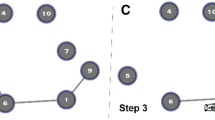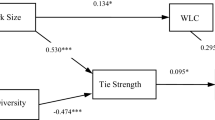Abstract
At present, the European Higher Education Area (EHEA) emphasizes the importance of collaborative learning in University education. Previous studies have found evidence to support collaborative activities; however, none have analyzed the influence of contact networks among students on their engagement and performance. This paper reports an intervention with nursing degree students aimed at facilitating an interdependent network to promote engagement and improve academic performance. The intervention was based on recording a video during a case study. The variables analyzed were network centrality, engagement and performance. The UCINET program was used to analyse social networks. The results showed a more cohesive network after the intervention and a high level of academic performance. The use of contact networks among students could be used as an academic strategy to build bridges between students in the classroom and even between these and students in other classrooms or centres.




Similar content being viewed by others
References
D. W. Johnson and R. T. Johnson, El aprendizaje cooperativo en el aula, Paidós, 1999.
Millis, B.J., Cooperative learning in higher education: Across the disciplines, across the academy. Stylus Publishing, LLC, Sterling, VA, 2010.
Prince, M.J., Does active learning work? A Review of the Research, Journal of Engineering Education. 93(3):223–231, 2004.
Delgado, M.A., and Fonseca-Mora, M.C., The use of co-operative work and rubrics to develop competences. Education for Chemical Engineers. 5:e33–e39, 2010.
Vine Jara, A., and Ferreira Cabrera, A., Mejoramiento de la competencia comunicativa en español como lengua extranjera a través de la videocomunicación. Revista de Lingüística Teórica y Aplicada. 50(1):139–160, 2012.
N. González Fernández and M. R. García Ruiz, El Aprendizaje Cooperativo como estrategia de Enseñanza-Aprendizaje en Psicopedagogía (UC): repercusiones y valoraciones de los estudiante, Revista Iberoamericana de Educación, vol. 42, no. 6, 2007.
Gallego, J.R., Redondo, A., Lorente, R., and Benedito, A., La coordinación entre profesores como base del nuevo aprendizaje universitario. Arxius. 24:119–134, 2011.
J. A. Barnes, Class and committees in a Norwegian island parish, in Social Network Analysis: A Handbook, 2nd ed, ed., vol. 7, Newbury Park, CA: Sage, (1954) - 2006, pp. 39–58.
Wasserman, S., and Faust, K., Social network analysis: Methods and applications. Cambridge University Press, 2007.
Lorrain, F., and White, H.C., Structural equivalence of individuals in social networks. Journal of Mathematical Sociology. 1:49–80, 1971.
Sparrowe, R., Liden, R., Wayne, S., and Kraimer, M., Social networks and the performance of individuals and groups. Academy of Management Journal. 44(2):316–325, 2001.
Repiso, R., Torres, D., and Delgado, E., Análisis bibliométricos y de redes sociales en tesis doctorales españolas sobre televisión (1976-2007). Comunicar. 37:151–159, 2011.
Grant, J., Proactive behaviour in the organizations. Journal of Management. 26:435–462, 2000.
Salanova, M., Llorens, S., Cifre, E., Martínez, I., and Schaufeli, W.B., Perceived collective efficacy subjective well-being and task performance among electronic work groups: An experimental study. Small Group Research. 34:43–73, 2003.
Schaufeli, W.B., Martínez, I., Marqués-Pinto, A., Salanova, M., and Barkker, A., Burnout and engagement: A multi-sample study. Journal of Organizational Behaviour. 25:293–315, 2002.
Linnenbrink, E.A., Emotion research in education: Theoretical and methodological perspective on the integration of affect, motivation and cognition. Educational Psycology Review. 18:307–314, 2006.
Salanova, M., and Schaufeli, W.B., A cross-national study of work engagement as a mediator between job resources and proactive behaviour. The International Journal of Human Resource Management. 19:116–131, 2008.
Freeman, L.C., Centrality in social networks. Conceptual clarification. Social Networks. 1:215–239, 1979.
Bonachich, S.P., and Lloyd, P., Eigenvector –like measures of centrality for asymmetric relations. Social Networks. 23:191–201, 2001.
Borgatti, S.P., Everett, M.G., and Freeman, L.C., Ucinet for windows: Software for social network analysis. Analytic Technologies, Harvard, 2002.
L. Salmerón, Actividades que promueven la transferencia de los aprendizajes: una revisión de la literatura, Revista de Educación, vol. Extraordinary, pp. 34–53, 2013.
Schwartz, D., and Bransford, J., A time for telling. Cognition and Intruction. 16:475–522, 1998.
Author information
Authors and Affiliations
Corresponding author
Additional information
This article is part of the Topical Collection on Education & Training
Rights and permissions
About this article
Cite this article
Marqués-Sánchez, P., Alfonso-Cendón, J., Fernández-Martínez, M.E. et al. Co-operative Networks and their Influence on Engagement: A Study with Students of a Degree in Nursing. J Med Syst 41, 103 (2017). https://doi.org/10.1007/s10916-017-0747-y
Received:
Accepted:
Published:
DOI: https://doi.org/10.1007/s10916-017-0747-y




